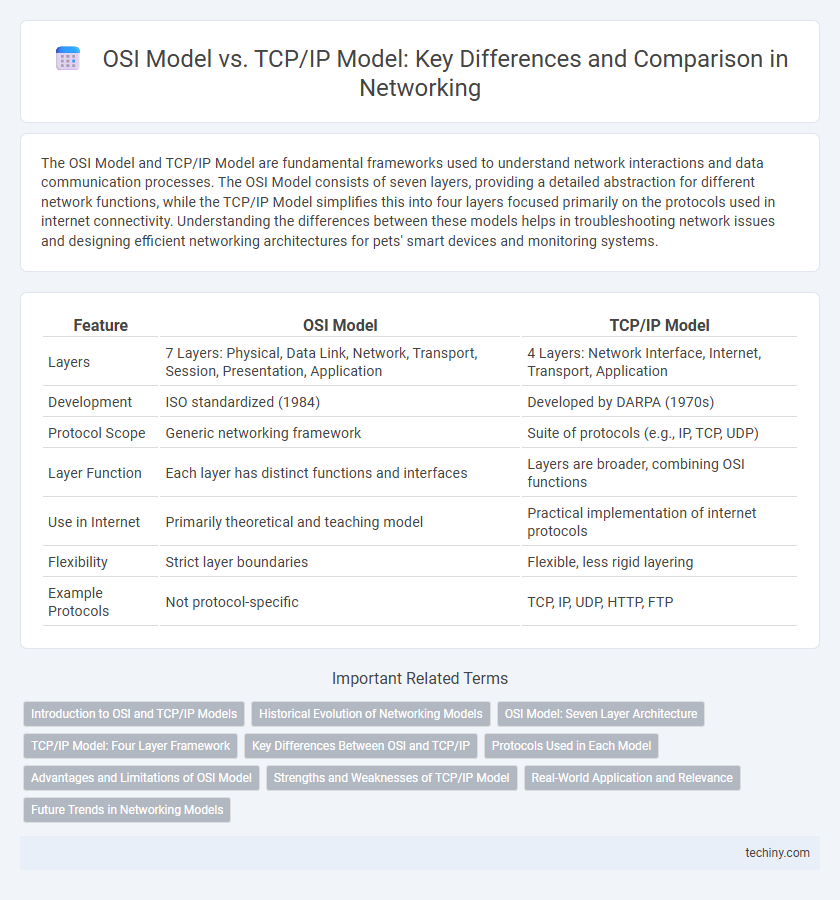The OSI Model and TCP/IP Model are fundamental frameworks used to understand network interactions and data communication processes. The OSI Model consists of seven layers, providing a detailed abstraction for different network functions, while the TCP/IP Model simplifies this into four layers focused primarily on the protocols used in internet connectivity. Understanding the differences between these models helps in troubleshooting network issues and designing efficient networking architectures for pets' smart devices and monitoring systems.
Table of Comparison
| Feature | OSI Model | TCP/IP Model |
|---|---|---|
| Layers | 7 Layers: Physical, Data Link, Network, Transport, Session, Presentation, Application | 4 Layers: Network Interface, Internet, Transport, Application |
| Development | ISO standardized (1984) | Developed by DARPA (1970s) |
| Protocol Scope | Generic networking framework | Suite of protocols (e.g., IP, TCP, UDP) |
| Layer Function | Each layer has distinct functions and interfaces | Layers are broader, combining OSI functions |
| Use in Internet | Primarily theoretical and teaching model | Practical implementation of internet protocols |
| Flexibility | Strict layer boundaries | Flexible, less rigid layering |
| Example Protocols | Not protocol-specific | TCP, IP, UDP, HTTP, FTP |
Introduction to OSI and TCP/IP Models
The OSI Model consists of seven layers--Physical, Data Link, Network, Transport, Session, Presentation, and Application--each defining specific network functions to standardize communication protocols. The TCP/IP Model, with four layers--Network Interface, Internet, Transport, and Application--serves as the foundation for the internet by providing a streamlined framework for data transmission. Understanding both models is essential for network design, troubleshooting, and the implementation of interoperability between diverse systems.
Historical Evolution of Networking Models
The OSI Model, developed by ISO in the 1980s, provided a comprehensive seven-layer framework to standardize network communication, influencing early networking protocols and education. The TCP/IP Model, originally created by DARPA in the 1970s for ARPANET, offered a practical four-layer protocol suite that became the foundation for the modern internet. The evolution from OSI to TCP/IP models reflects the shift from theoretical design to implementation-driven standards in networking history.
OSI Model: Seven Layer Architecture
The OSI Model consists of seven distinct layers: Physical, Data Link, Network, Transport, Session, Presentation, and Application, each responsible for specific networking functions to standardize communication protocols. This seven-layer architecture facilitates interoperability between diverse systems by clearly defining the roles and processes at each level, from hardware transmission to application-level data handling. Understanding the OSI Model's layered framework is crucial for diagnosing network issues and designing robust communication protocols.
TCP/IP Model: Four Layer Framework
The TCP/IP model consists of four layers: the Link layer, Internet layer, Transport layer, and Application layer, each responsible for specific networking functions. The Link layer handles physical network hardware and media access, while the Internet layer manages logical addressing and routing using IP protocols. The Transport layer ensures end-to-end communication reliability through protocols like TCP and UDP, and the Application layer provides network services directly to user applications such as HTTP, FTP, and SMTP.
Key Differences Between OSI and TCP/IP
The OSI model consists of seven layers--Physical, Data Link, Network, Transport, Session, Presentation, and Application--while the TCP/IP model has four layers: Link, Internet, Transport, and Application. Unlike OSI, which is a theoretical framework, TCP/IP is a practical protocol suite designed for real-world internetworking. The OSI model separates session and presentation functions, whereas TCP/IP combines these into the application layer for streamlined communication.
Protocols Used in Each Model
The OSI model consists of seven layers, each utilizing specific protocols such as HTTP, FTP, and SMTP at the application layer, TCP and UDP at the transport layer, and IP at the network layer. In contrast, the TCP/IP model is composed of four layers, using protocols like HTTP, FTP, and SMTP in the application layer, TCP and UDP in the transport layer, IP in the internet layer, and ARP, ICMP in the network interface layer. These protocol sets define the communication standards and data exchange rules within each model, shaping how devices interact over a network.
Advantages and Limitations of OSI Model
The OSI Model offers a comprehensive seven-layer framework that standardizes networking functions, promoting interoperability and troubleshooting across diverse systems. Its abstraction facilitates clear protocol development and enhances modularity, which simplifies updates and technological integration. However, the OSI Model's theoretical design results in limited practical adoption, increased complexity, and redundancy compared to the more streamlined and widely implemented TCP/IP Model.
Strengths and Weaknesses of TCP/IP Model
The TCP/IP model offers robust practical implementation across diverse networks due to its simplicity and scalability, enabling efficient protocol development and deployment in real-world internet systems. Its primary weakness lies in reduced granularity since it combines multiple OSI layers, which can limit detailed network diagnostics and hinder comprehensive standardization efforts. Despite these drawbacks, TCP/IP's alignment with IP addressing and routing protocols underpins the global internet's reliability and interoperability.
Real-World Application and Relevance
The OSI Model provides a comprehensive framework with seven distinct layers, enhancing conceptual clarity and troubleshooting in complex network environments. The TCP/IP Model, with its four layers, offers a practical protocol suite widely adopted for real-world Internet communication and network interoperability. Network engineers rely on the OSI Model for detailed protocol analysis while leveraging the TCP/IP Model for efficient design and implementation of global data transmission.
Future Trends in Networking Models
Future networking models are increasingly integrating AI-driven protocols to optimize data flow and enhance security across both OSI and TCP/IP frameworks. Advancements in quantum computing and 5G/6G technologies demand adaptable models that support ultra-low latency and massive IoT connectivity beyond traditional layer boundaries. The convergence of software-defined networking (SDN) and network function virtualization (NFV) will further redefine model architectures, promoting dynamic, scalable, and programmable network infrastructures.
OSI Model vs TCP/IP Model Infographic

 techiny.com
techiny.com